
Join us on our trip around New Zealand
in our tubby travelling home, Gerty
Stranded Pilot Whales
Part Three
| |
| HOME |
| About Tenaya |
| About Us |
| Latest Update |
| Logs from Current Year |
| Logs from Previous Years |
| Katie's View |
| Route Map |
| Links |
| Contact Us |
![]()
February 8, 2011
Farewell Spit was named by Captain Cook as he left New Zealand in 1770. It is the northernmost bit of land on New Zealand's South Island. Stretching 25 km to the east it is a natural reserve of shifting sand dunes up to 30 meters high. Arching south from the base is beautiful Golden Bay named for the gorgeous color of eroding granite from nearby mountains.
This sand is pushed northward by coastal drift continuing to build the spit and keeping the bay shallow. Because the tidal range can be 4.5 meters at springs tide (full or new moon), vast sand and mudflats up to 6 km wide are exposed. Saturday was a springs tide.
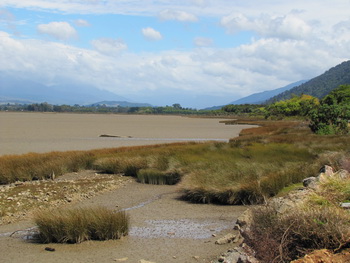
Golden Bay at low water
Pilot whales are the most common whales in New Zealand. It is not uncommon for them to strand off of Farewell Spit or in the northern part of Golden Bay. Nobody knows why but scientists speculate the whales may have some sort of internal navigational system like SONAR which is thrown off by the shallow water.
When heading north, the whales must go 25 km. to the east to clear the spit and it is believed the creatures cannot detect this.
Once they have stranded once and lost members of their pod it seems they are likely to beach a second and third time before the strong survivors make a mad dash for deep water and stay there.
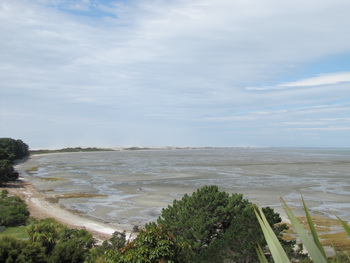
Looking north from Paponga to Triangle Flat and beyond to Farewell Spit
Friday afternoon we arrived back at our campsite in Moteuka jubilant after our three day kayaking trip. Jim fired up the computer to see what was going on in the world and learned of 82 pilot whales stranded at Paponga, the base of Farewell Spit. One article asked for 200 volunteers to show up clad in wetsuits to help refloat them at noon the next day which was high water.
After the incredible encounter with dolphins we'd just experienced, we felt we must do what we could to help these distressed aquatic mammals. As our wetsuits are still on Tenaya, we rented some first thing the following morning drove the 150 km. to Paponga as fast as Gerty could manage over the mountains.
Fortunately all the whales that lived through the night refloated as the tide came in. The two men at the Dept. of Conservation (DOC) whale rescue trailer suggested we stick around if possible as some of the pod were behaving strangely and they worried the whales would strand again when the tide went out.
They did and everyone dashed a few km. north to Triangle Flat, the farthest point cars are able to drive. We walked as fast as we could down the beach then waded more than a km. to reach the first whale while trucks transported people farther down the beach to reach those whales further out.

2:00 pm: The water has begun to recede at Triangle Flat.

9:00 pm: Everyone is back at their cars at Triangle Flat hoping the whales refloat during the next high tide just after midnight.
About 40 of the 66 whales that refloated overnight restranded at Triangle Flat Saturday afternoon. A short time later approximately 25 more stranded a few kilometers south.
The DOC and Project Jonah volunteers did a marvelous job righting the whales and teaching all the unexperienced volunteers what to do before many of them had to leave, taking with them lots of buckets and shovels to aid the other group of stranded whales.
We met many local people well-trained and well-practiced to deal with stranded whales. They moved about with a somber air having dealt with this particular pod for more than 24 hours. Sadly, they are called upon more frequently than anyone would like.
.
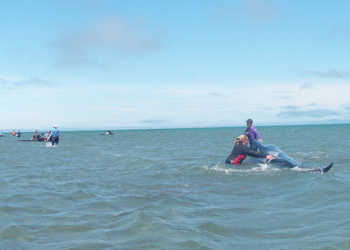
Look how much water there was when we reached the first whale about 2:45 pm.
For about an hour this whale made whistling sounds which could not be called a song under these circumstances. Whales make two kinds of sounds, whistling for communication and a clicking sound which they use like SONAR to judge distances.
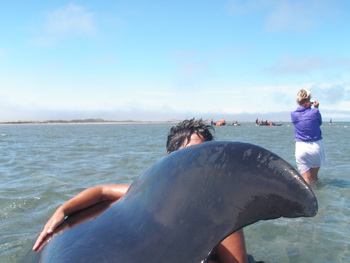
We helped the two people pictured above right this first one, the largest of the pod.
Pilot whales average 4-6 meters and Jim and one of his helpers, a belgian backpacker, estimated this one to be well over 6 meters.
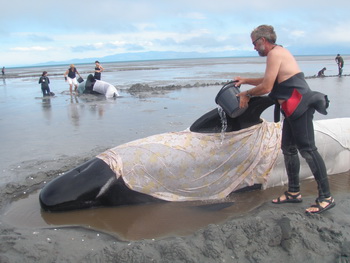
As the tide receded we dug trenches around the whales to keep them in water and poured buckets of water over them.
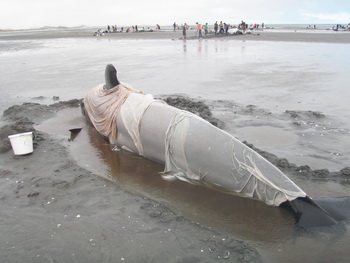
Covering them with sheets helps keep their skin wet which is essential.

Once we had the first whale upright Jim continued to splash buckets of water on it while I moved on to help the next whale.
A couple of other people were helping with "my" whale so I took the opportunity to stretch my back and legs by walking around. It was heartbreaking seeing all the stranded whales. One tiny calf about a meter long was laying nose to nose next to its mother. Another older calf had a large cut across its head and kept screaming its high pitched whistle.
At one point "Jim's" whale quickly raised its fluke head-high and slapped it down on the sand half a meter away. Yikes, that was scary - so much power! Now we understood why we were told to stay away from the tail.
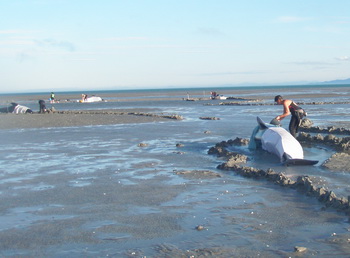
Less people remain tending the whales as evening approached.
Early in the afternoon many people came to look and help. As the day wore on and it cooled down most left. We could not leave "our" whales. It was very emotional and we'd become attached to them.

I will never forget this face. I hope he/she survived.
I had a feeling "mine" would survive because it seemed like a fighter. It was alert and active, moving its head and pectoral fins. Halfway through the ordeal he/she began opening its right eye and looking at me as I spoke softly to it.
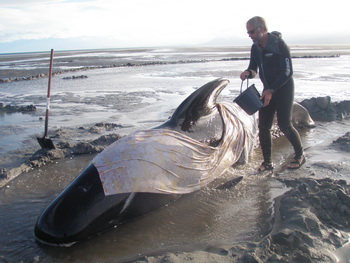
We continued to pour buckets of water on "our" whales until we were told to leave at 8:30 pm.
Walking away from "ours" and all the other whales was incredibly emotional.
We were saddened to read several more whales died when the pod stranded again the following day before being refloated. But the tide has changed several times since and they have not returned. Please stay at sea.
Central South Island - East Coast